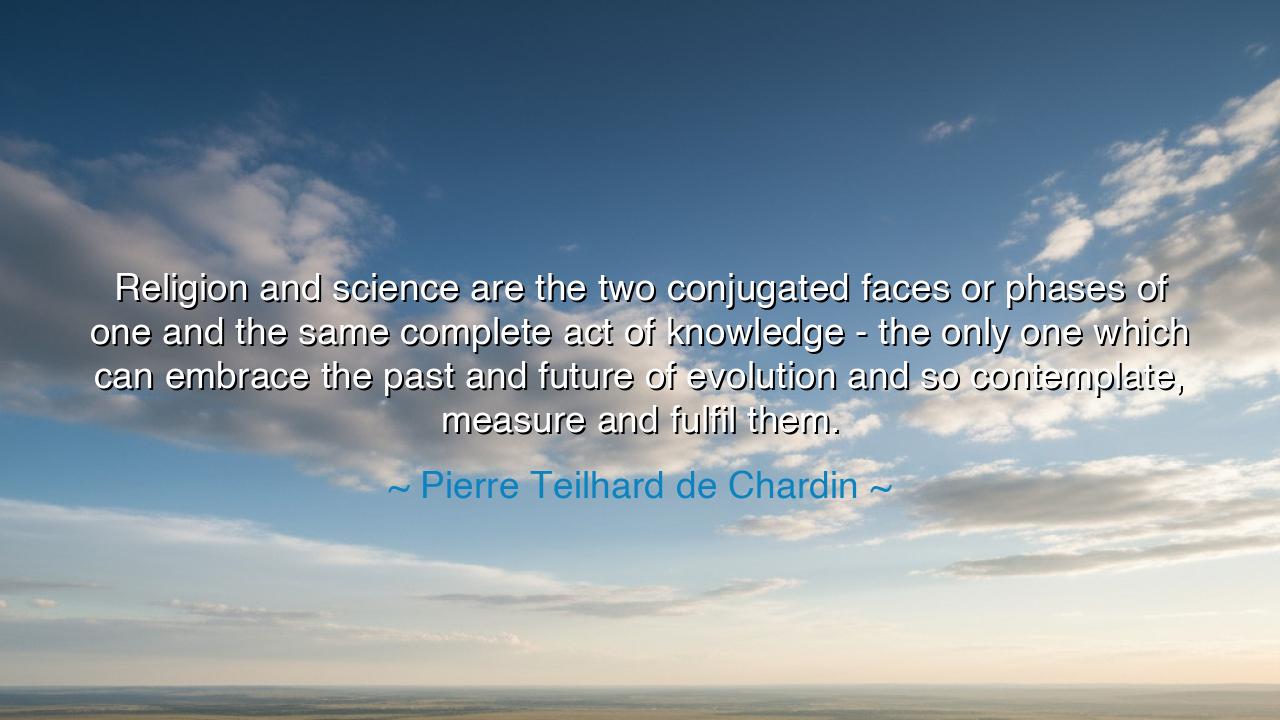
Religion and science are the two conjugated faces or phases of
Religion and science are the two conjugated faces or phases of one and the same complete act of knowledge - the only one which can embrace the past and future of evolution and so contemplate, measure and fulfil them.






Hear, O seekers of wisdom, the profound words of Pierre Teilhard de Chardin, priest, philosopher, and scientist, who declared: “Religion and science are the two conjugated faces or phases of one and the same complete act of knowledge—the only one which can embrace the past and future of evolution and so contemplate, measure, and fulfil them.” These are not light utterances, but a vision born of struggle: the struggle to unite what men had torn apart, to weave into harmony the faith of the spirit and the discoveries of the mind.
Teilhard lived in a time when many set religion and science against one another, as though they were enemies locked in endless strife. But he, a Jesuit priest and a paleontologist, saw with deeper eyes. He believed that science, with its exploration of matter, and religion, with its search for meaning, are not opposites but companions—two lenses through which humanity may behold the fullness of truth. One without the other is partial; together, they form a complete act of knowledge, embracing both the origins of the cosmos and the destiny of the soul.
Consider the tale of Copernicus and Galileo. When they looked to the heavens and declared that the earth moved around the sun, their discoveries seemed to strike against the teachings of their time. Yet what appeared as conflict was in truth a deeper unfolding of divine order. The science of astronomy revealed the grandeur of creation; the religion of faith proclaimed that such grandeur had purpose. Though men erred in setting them at war, in truth they were two mirrors reflecting one light. Teilhard saw this clearly: that the unity of knowledge requires both the probing of reason and the reverence of faith.
And ponder the life of Teilhard himself, laboring among ancient fossils in the deserts of China, uncovering the bones of early man. To the narrow mind, such work might seem to threaten religion. But Teilhard perceived instead the unfolding of evolution as a sacred drama, a story written not against God but through Him. For to him, the journey of life from dust to thought, from chaos to consciousness, was both a scientific truth and a divine revelation. In his vision, religion and science clasped hands, contemplating the past and stretching toward the future together.
Yet his words are also a warning. When science walks alone, it may master matter but lose meaning; when religion walks alone, it may inspire faith but neglect the workings of the world. Only when united can they “contemplate, measure, and fulfil” the vast sweep of human destiny. Without this union, mankind risks either building machines without conscience, or clinging to faith without wisdom. But with this union, mankind may rise, guided both by knowledge of the stars and by reverence for the soul.
The lesson is clear: do not despise either path. Do not pit reason against faith, nor set religion at war with science. Instead, cultivate both within yourself. Let your mind explore the mysteries of the universe, but let your heart seek the higher purpose behind them. Study deeply, but also pray deeply. Build with your hands, but also reflect with your spirit. For the fullness of knowledge lies not in division, but in wholeness.
Practical actions stand before you. Read the works of scientists with openness, and let them deepen your wonder. Read the words of sages and saints, and let them guide your purpose. Teach your children not only how the world works, but why it matters. And when you face the mysteries of life—birth and death, triumph and suffering—approach them with both the clarity of science and the humility of religion.
So carry Teilhard’s vision with you: religion and science are not foes, but two faces of truth, shining together. One measures the vastness of the heavens; the other gives them meaning. One traces the steps of evolution; the other reveals its destiny. Together, they lead humanity to contemplate the past, to shape the present, and to fulfil the future. This is the wisdom of the ages, and the path of those who would truly know.






AAdministratorAdministrator
Welcome, honored guests. Please leave a comment, we will respond soon